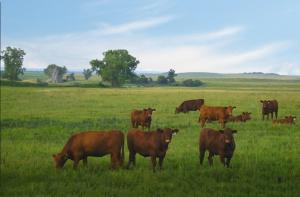
The Regional Conservation Partnership Program (RCPP) is a partner-driven approach to conservation that funds solutions to natural resource challenges on agricultural land.
On This Page
NRCS North Dakota Announces Regional Conservation Partnership Program (RCPP) Funding Opportunity for the Meadowlark Initiative
Natural Resources Conservation Service (NRCS), Financial Assistance and Stewardship Farm Bill Programs operate under a continuous sign-up; therefore, applications are accepted on a continuing basis throughout the year and cutoff dates are scheduled to allow for ranking, prioritizing, and selection of applications for funding. The FY 2023 RCPP Program cutoff date (batching) for FY 2023 Meadowlark Initiative applications is October 28, 2022. Applications on file by close of business (COB) will be considered for funding under the FY 2023 allocation for the following funding pools:
Meadowlark Initiative
RCPP Meadowlark Initiative Informational Webinar for NRCS Staff

Lead Partner: Little Missouri Grazing Association
Funding Amount: $648,131
Lead State: ND
The Meadowlark Initiative is a new statewide strategy focused on two goals in North Dakota: 1) improve, increase and connect wildlife habitat, and 2) support the sustainability of new and existing livestock ranches. Fourteen project partners have agreed to pool contributions to leverage RCPP funding using an innovative spatial modeling approach to prioritize land management and rental conservation activities. The partners aim to convert 20,000 acres of marginal cropland to diverse native perennial vegetation; enhance 50,000 acres of existing and reconstructed native grasslands; and restore and enhance 10,000 acres of wetlands within reconstructed grassland complexes.
NRCS North Dakota Announces Regional Conservation Partnership Program (RCPP) Funding Opportunity for the Little Missouri Grazing
Natural Resources Conservation Service (NRCS), Financial Assistance and Stewardship Farm Bill Programs operate under a continuous sign-up; therefore, applications are accepted on a continuing basis throughout the year and cutoff dates are scheduled to allow for ranking, prioritizing, and selection of applications for funding. The FY 2023 RCPP Program cutoff date (batching) for applications is September 23, 2022. Applications on file by close of business (COB) will be considered for funding under the FY 2023 allocation for the following Little Missouri Grazing Association. The Little Missouri Grazing Association will use land management contracts with producers to restore and enhance degraded rangelands in the Prairie Grasslands of North Dakota. Solar water wells, cross fencing, riparian restoration, and prescribed grazing will be used to address resource concerns on over 11,000 degraded rangelands and transition the land toward a native grass and forb plant community
Little Missouri Grazing Association

The Little Missouri Grazing Association will use land management contracts with producers to restore and enhance degraded rangelands in the Prairie Grasslands of North Dakota. Solar water wells, cross fencing, riparian restoration, and prescribed grazing will be used to address resource concerns on over 11,000 degraded rangelands and transition the land toward a native grass and forb plant community.
Program Contacts:
Mark Hayek
ASTC-Partnership Coordinator
(701) 530-2080
mark.hayek@usda.gov
Jarvis R. Keney
Assistant State Conservationist (Programs)
(701) 530.2005
jarvis.keney@usda.gov
Ready to get started?
Contact your local service center to start your application.
How to Get Assistance
Do you farm or ranch and want to make improvements to the land that you own or lease?
Natural Resources Conservation Service offers technical and financial assistance to help farmers, ranchers and forest landowners.

To get started with NRCS, we recommend you stop by your local NRCS field office. We’ll discuss your vision for your land.
NRCS provides landowners with free technical assistance, or advice, for their land. Common technical assistance includes: resource assessment, practice design and resource monitoring. Your conservation planner will help you determine if financial assistance is right for you.
We’ll walk you through the application process. To get started on applying for financial assistance, we’ll work with you:
- To fill out an AD 1026, which ensures a conservation plan is in place before lands with highly erodible soils are farmed. It also ensures that identified wetland areas are protected.
- To meet other eligibility certifications.
Once complete, we’ll work with you on the application, or CPA 1200.
Applications for most programs are accepted on a continuous basis, but they’re considered for funding in different ranking periods. Be sure to ask your local NRCS district conservationist about the deadline for the ranking period to ensure you turn in your application in time.
As part of the application process, we’ll check to see if you are eligible. To do this, you’ll need to bring:
- An official tax ID (Social Security number or an employer ID)
- A property deed or lease agreement to show you have control of the property; and
- A farm number.
If you don’t have a farm number, you can get one from USDA’s Farm Service Agency. Typically, the local FSA office is located in the same building as the local NRCS office. You only need a farm number if you’re interested in financial assistance.
NRCS will take a look at the applications and rank them according to local resource concerns, the amount of conservation benefits the work will provide and the needs of applicants. View Application Ranking Dates by State.
If you’re selected, you can choose whether to sign the contract for the work to be done.
Once you sign the contract, you’ll be provided standards and specifications for completing the practice or practices, and then you will have a specified amount of time to implement. Once the work is implemented and inspected, you’ll be paid the rate of compensation for the work if it meets NRCS standards and specifications.

